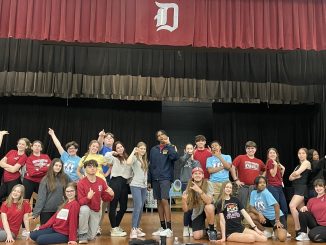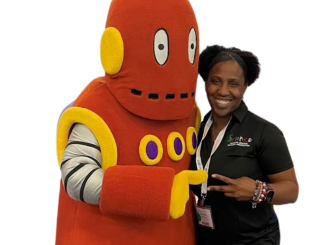
Barry Guillot’s hands have just been pricked by an albino hedgehog.
That might seem like an unusual thing to happen to a seventh grade science teacher during the course of a school day, but it’s hardly an unusual occurrence for Guillot.
“The kids just love the animals,” Guillot said. “Today I had an albino hedgehog and I told the kids to be quiet or it might just prick me. Of course, they started making a lot of noise.”
Guillot has just exited Harry Hurst Middle School and is heading out to the Bonnet Carré Spillway. Recent events at the spillway have caused Guillot to switch the location for his 10th Wetland Watcher celebration.
The celebration, which brings 500 fifth grade students, along with industry representatives, Disney Radio and Amanda Shaw, out each year to help celebrate conserving the wetlands, is usually held at Guillot’s Wetland Watcher Park.
With the spillway open, this year’s celebration will be set up behind the spillway office instead of the park because the road leading to it is flooded.
Though setting up the event is always a hectic chore for Guillot, it’s something he is used to.
Guillot is a renaissance man of sorts and has worked as a bouncer on Bourbon Street, a sergeant in the army and has also helped train security guards. He says that all of those jobs helped prepare him for dealing with middle school students.
Guillot, of course, never thought he would be a teacher. Instead, he had planned to make a career in the hotel service industry. But while in college, Guillot happened into a teaching career when he subbed for a kindergarten teacher for six weeks.
“I had heard that you don’t even smile for the first two weeks so that you make the kids think you’re mean,” Guillot said. “The first day, I had them in the reading circle and they all started crying. I brought them back on my lap and they sat there and did well, but they all knew I was nice after that.”
Though the experience lasted only six weeks, it made a big impression on Guillot. He went into the army the next year, and eventually started working for a security firm that trained security guards on movie sets.
“I always missed teaching though and I missed the connection I had with the kids,” Guillot said.
Guillot called the same school that he had taught kindergarten back and asked if they needed any help. They did and Guillot made his way back to the school.
“I can still remember walking up to the porch and thinking whether or not I could handle 20 or 25 of these kids because it had been so long,” he said. “I had been shot at, been through army training and yet I was scared to go in this classroom with all these kids.”
Guillot eventually worked up the nerve to enter the building, and just so happened to come across the same kindergarten class that he had taught the previous year.
“Sure enough, right down the hallway, they were all walking to the bathroom,” he said. “One by one they broke the line and started jumping on me. It was at that point where I looked up and said ‘I’m never going to leave ya’ll again.'”
Guillot went back to college and got into education.
“I’ve never wavered from that,” he said.
Eventually Guillot’s life would be changed forever when he went on a service learning trip with the University of New Orleans. Service learning is where students meet all their academic requirements through activities that help enhance the environment and the community. Guillot realized how beneficial the program was, and brought it into his classroom.
“So when we go on a service trip now, we plant trees, pick up trash and do water quality testing,” he said. “Those are all activities that directly benefit the community and the kids are meeting their required academics.”
10 years ago, Guillot wrote his first grant to the Lieutenant Governor’s office and got $5,000 for service learning. He also adopted an area in the spillway in order to make it an outdoor classroom.
“I couldn’t believe it and it’s just something that I started working with the kids to build,” Guillot said. “At first, we did water quality testing and worked with the animals, but I started asking them what else they thought we should do. They wanted to plant trees, so I started calling people to get enough.”
Guillot has 150 students in his classes and had no idea how he would ever manage to get that many trees. He started calling around and eventually got together with the USDA and the RCS, who told him they would give him 150 trees.
“I was shocked because the trees were around $30 to $40 a piece,” Guillot said. “From that point on I realized that there are a lot of people in the state and our community that want to help out, but don’t realize how they can.
“My job is to figure out what the kids want to do, who can helps us with it and how they can help.”
Service learning opened a whole new door to Guillot because it allowed him to get more hands-on with his teaching technique. For example, if Guillot’s students are going to study reptiles, they don’t just look up information on the internet. They come into class and have snakes, alligators and snapping turtles staring back at them.
While the students were excited to feel and touch the animals from the comfort of their own classroom, it was the service trips themselves that really became popular.
“We started off doing a few service trips with my class, but then other people started complaining that you had to be in my class to go on one,” Guillot said. “So we made it a whole seventh grade trip and eventually made it a whole school trip. But every time we increased the amount of kids that would go, we had to increase the reason to go.”
Guillot did that by involving other kids from other schools.
Now, his students take other students on service trips, where they get the chance to serve as mentors. Guillot’s students have also begun giving speeches at festivals around the state. This year, those students will speak to over 85,000 people.
“My kids are awesome at their speeches,” Guillot said. “I tell them that they can be the smartest kids in the world, but if they don’t know how to communicate what they know, then it’s useless.”
Four years ago, the land that Guillot first adopted was donated to the parish by the levee district. However, the levee district didn’t just donate the adopted land, but added an additional 28 acres. The parish then named the park Wetland Watcher Park after Guillot and his band of students.
When it’s all said and done, Wetland Watcher Park will have three outdoor classrooms, three quarters of a mile of boardwalk trail, a 10 foot marsh overlook, two fishing piers, picnic areas and a pirate themed playground for kids.
Guillot thanks local environmentalist Milton Cambre with attaining that land by writing grants and working with industry to reclaim three acres.
“Mr. Milton is an integral part of what we’re doing,” Guillot said. “We wouldn’t have that land if it wasn’t for him. He’s my hero.”
Now, Guillot is able to have eight service trips and one celebration a year. All in all, Guillot estimates that around 1,200 students from St. Charles Parish go on service trips every school year.
“People say that I’ve been doing this for 10 years and they don’t know why I’m still stressed,” Guillot said. “I know there are still so many ways that I can improve the project to make it even more successful.”
But even though his project has been extremely successful, there really is no rest for Guillot. After getting to the spillway, he meets with several corps officials about the best place to have the Wetland Watcher Celebration. Because the weather has been so hard to judge recently, Guillot has to pick up three spots. He draws a map with the location for where he thinks the tent will go in each of the three locations.
Still though, Guillot admits that the way his project is now, is so much more than he ever thought possible.
“I never, never, never thought it would get this big,” he said. “I never dreamed we would have the land donated and I never thought we would have 1,200 kids going out there. It was just supposed to be a good place to take my 150 kids for an outdoor classroom experience.”




Be the first to comment